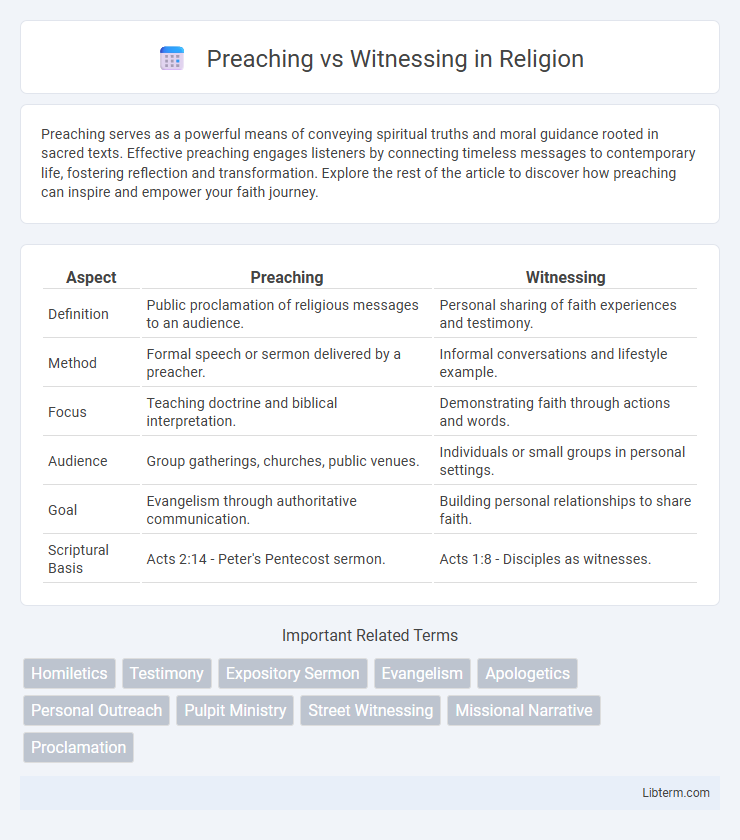Preaching serves as a powerful means of conveying spiritual truths and moral guidance rooted in sacred texts. Effective preaching engages listeners by connecting timeless messages to contemporary life, fostering reflection and transformation. Explore the rest of the article to discover how preaching can inspire and empower your faith journey.
Table of Comparison
| Aspect | Preaching | Witnessing |
|---|---|---|
| Definition | Public proclamation of religious messages to an audience. | Personal sharing of faith experiences and testimony. |
| Method | Formal speech or sermon delivered by a preacher. | Informal conversations and lifestyle example. |
| Focus | Teaching doctrine and biblical interpretation. | Demonstrating faith through actions and words. |
| Audience | Group gatherings, churches, public venues. | Individuals or small groups in personal settings. |
| Goal | Evangelism through authoritative communication. | Building personal relationships to share faith. |
| Scriptural Basis | Acts 2:14 - Peter's Pentecost sermon. | Acts 1:8 - Disciples as witnesses. |
Understanding Preaching: Definition and Purpose
Preaching is the act of delivering a structured and authoritative message based on religious scriptures, aimed at educating, inspiring, and persuading an audience toward spiritual growth. Its primary purpose is to communicate theological truths and moral teachings clearly, often within a formal setting such as a church service. Unlike witnessing, preaching focuses on doctrinal exposition and exhortation to deepen faith and understanding among believers.
What is Witnessing? A Clear Explanation
Witnessing refers to sharing personal experiences and testimony about one's faith, emphasizing authentic, relatable stories rather than formal sermons. It involves engaging conversations that reflect genuine belief and the impact of spiritual transformation in everyday life. Witnessing aims to inspire and connect on a personal level, fostering understanding and openness to faith.
Key Differences Between Preaching and Witnessing
Preaching involves delivering a structured, often public message aimed at teaching or persuading an audience about religious or spiritual truths, frequently using scripture as a foundation. Witnessing focuses on sharing personal experiences and testimonies to demonstrate the impact of faith in one's life, fostering connection through authentic storytelling. The key difference lies in preaching's formal, authoritative tone versus witnessing's informal, relational approach.
The Biblical Basis for Preaching
Preaching is rooted in biblical commands such as Jesus' Great Commission in Matthew 28:19-20, where followers are instructed to teach all nations, emphasizing proclamation of the gospel. The Apostle Paul models preaching as a purposeful proclamation of Christ's salvation, demonstrated in Acts 20:24 and Romans 10:14, underscoring the necessity of verbal witness. Biblical preaching serves as authoritative teaching that interprets Scripture and calls for repentance, distinguishing it from the more personal and experiential nature of witnessing.
Scriptural Foundations of Witnessing
Witnessing is grounded in scriptural mandates such as Acts 1:8, where Jesus commands believers to be His witnesses "to the ends of the earth," emphasizing personal testimony and relational sharing of faith. Unlike formal preaching, witnessing involves living out the Gospel daily and verbally sharing Christ's transformative power in everyday situations, as seen in John 4 with the Samaritan woman's testimony. The Great Commission in Matthew 28:19-20 underpins witnessing by calling Christians to make disciples through baptism and teaching, reinforcing the relational and experiential nature of spreading the Gospel.
Methods of Effective Preaching
Effective preaching employs clear, engaging storytelling and practical application to connect biblical truths with listeners' daily lives. Utilizing varied vocal tones, body language, and visual aids helps maintain attention and emphasizes key messages. Incorporating interactive elements, such as rhetorical questions and real-life examples, enhances retention and encourages personal reflection.
Practical Ways to Witness to Others
Effective witnessing involves sharing personal experiences and demonstrating genuine love through actions, which often resonates more deeply than formal preaching. Engaging in active listening and asking thoughtful questions helps build trust and opens meaningful dialogue about faith. Practical ways include volunteering, offering help in daily situations, and living consistently with your beliefs to naturally inspire curiosity and interest in others.
The Role of Preaching in Church Growth
Preaching plays a central role in church growth by effectively communicating biblical truths that inspire spiritual transformation and community engagement. It fosters doctrinal understanding and reinforces the church's mission, attracting new believers and deepening the faith of existing members. Strategic preaching enhances outreach efforts by equipping the congregation to witness with conviction and clarity.
How Personal Testimony Enhances Witnessing
Personal testimony enhances witnessing by creating an emotional connection and making abstract beliefs relatable through genuine experiences. Sharing specific stories of transformation or faith struggles provides authenticity that resonates deeply, encouraging trust and openness in listeners. This method contrasts with preaching, which often involves delivering doctrinal messages, emphasizing the power of lived experience to inspire and engage others effectively.
Preaching and Witnessing: Choosing the Right Approach
Preaching emphasizes delivering structured sermons to convey religious teachings, aiming for widespread understanding and doctrinal clarity. Witnessing involves personal testimony and relational sharing of faith experiences, fostering genuine connections and individualized impact. Choosing the right approach depends on context, audience receptivity, and goals for engagement within spiritual communities.
Preaching Infographic

 libterm.com
libterm.com